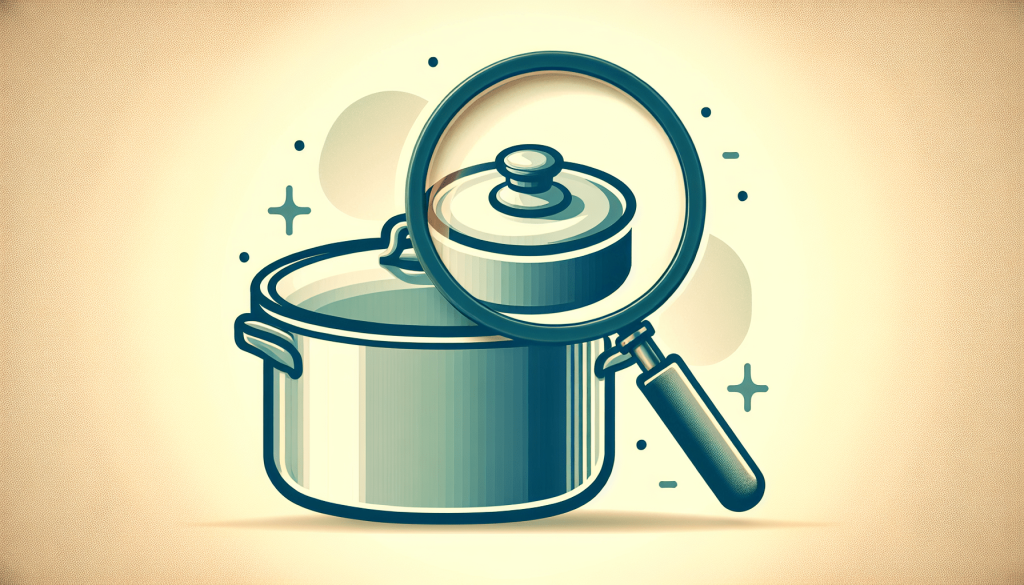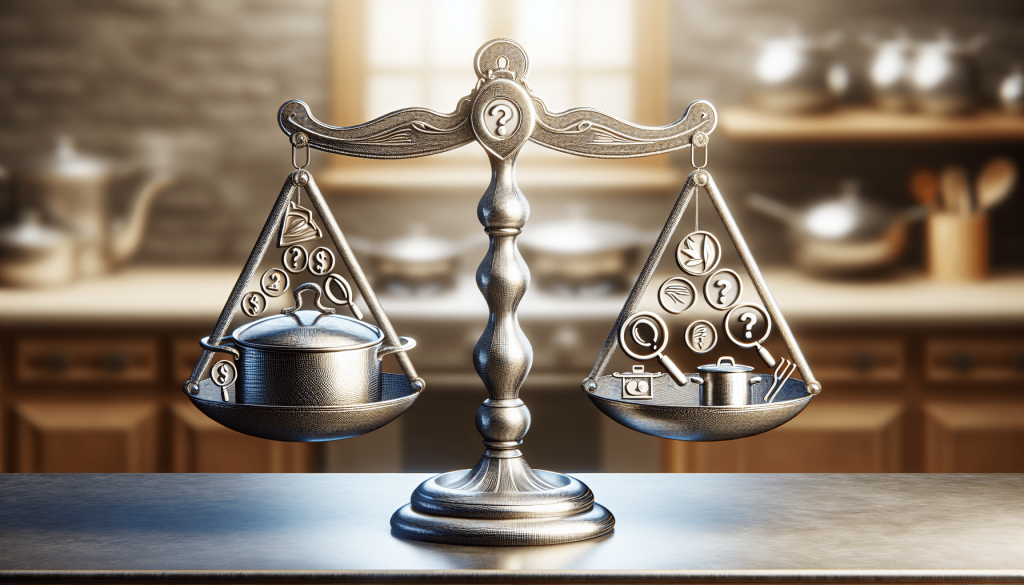Whether you love cooking or are just starting to explore the world of culinary delights, having the right cookware can make all the difference in creating delicious meals. But with so many options available, it can be overwhelming to choose the best cookware for your needs. Don’t fret, because in this article, you’ll discover practical tips and advice on how to make informed decisions when purchasing new cookware. From understanding different materials to considering your cooking style and budget, you’ll gain the knowledge and confidence to select the perfect pots and pans that will elevate your cooking experience. So, let’s embark on this exciting journey of finding the ideal cookware for you!
Consider your Cooking Needs
When it comes to selecting the right cookware for your kitchen, it’s important to consider your cooking needs. Start by assessing the types of dishes you frequently cook. Are you someone who loves making soups and stews, or do you prefer to whip up stir-fries and sautés? Understanding the types of dishes you often prepare will help you determine the specific cookware pieces you need.
Next, consider the size of cookware you require. Do you often cook for a large family or group of friends? If so, you’ll want to invest in larger pots and pans that can accommodate larger portions of food. On the other hand, if you usually cook for just yourself or a small household, smaller cookware sizes may be more suitable.
Finally, take into account the number of people you usually cook for. If you frequently entertain guests or have a large family, it’s important to have the right cookware that can handle larger quantities of food. However, if you mainly cook for yourself or a few people, you may not require the same size of cookware.
Choose the Right Material
The material of your cookware can greatly impact the cooking experience and the quality of your meals. Here are some common cookware materials to consider:
Stainless Steel
Stainless steel cookware is known for its durability and resistance to rust and corrosion. It is a popular choice for many home cooks and professional chefs alike. Stainless steel is also non-reactive, meaning it won’t impart any metallic tastes or flavors to your food. It is a versatile material that can be used for various cooking techniques and is compatible with all stovetop types.
Cast Iron
Cast iron cookware is renowned for its excellent heat retention and even heat distribution. It is ideal for dishes that require long, slow cooking, such as braises and stews. Cast iron can also be used on any stovetop and is oven-safe. However, it requires regular seasoning and maintenance to prevent rusting.
Non-Stick
Non-stick cookware has a special coating that prevents food from sticking to the surface. This makes it easier to cook delicate foods like eggs and pancakes without them tearing or breaking. Non-stick cookware is typically made from aluminum or stainless steel with a non-stick coating applied to the cooking surface. It is important to note that non-stick coatings can wear off over time and may require replacement.
Copper
Copper cookware is prized for its excellent heat conductivity, allowing for precise temperature control. It heats up quickly and evenly, making it ideal for delicate sauces and precise cooking techniques. However, copper cookware requires regular polishing and maintenance to keep its shiny appearance.
Aluminum
Aluminum cookware is lightweight, affordable, and has excellent heat conductivity. It heats up quickly and distributes heat evenly, making it a popular choice for many home cooks. However, bare aluminum cookware is prone to reacting with acidic foods, causing off-flavors and discoloration. To prevent this, most aluminum cookware is coated or anodized.

Evaluate Heat Conductivity
The heat conductivity of your cookware is crucial for achieving even cooking and preventing hot spots. Different materials have different heat conductivity properties, so it’s important to research and understand how they perform in this aspect.
Some materials, like copper and aluminum, have excellent heat conductivity and distribute heat evenly across the cooking surface. This ensures that your food cooks consistently and avoids any areas that are overcooked or undercooked. Other materials, such as stainless steel and cast iron, have lower heat conductivity and may require more precise heat adjustments during cooking.
Consider how evenly the cookware distributes heat and whether it will meet your specific cooking needs. If you often cook dishes that require precise temperature adjustments, such as delicate sauces or candies, opting for cookware with excellent heat conductivity will be beneficial.
Check Durability and Longevity
Durability and longevity are important factors to consider when investing in new cookware. You want to ensure that your cookware will last for years to come and withstand regular use. Here are some factors to consider:
Read customer reviews and ratings
Before making a purchase, it’s always a good idea to read customer reviews and ratings online. This can provide valuable insights into the durability of the cookware and how it holds up over time. Look for cookware that has consistently positive reviews and high ratings in terms of durability and longevity.
Consider the warranty offered by the manufacturer
A good warranty can give you peace of mind and assurance that the manufacturer stands behind their product. Check if the cookware comes with a warranty and what it covers. A longer warranty period generally indicates that the manufacturer is confident in the durability of their product.
Evaluate the thickness and quality of the materials used
Thicker cookware tends to be more durable and less prone to warping or denting. Assess the thickness of the cookware you are considering and check for any signs of flimsiness or poor craftsmanship. Additionally, examine the overall quality of the materials used, such as the construction of handles and lids, to ensure they are sturdy and well-made.

Assess Maintenance and Ease of Cleaning
Cookware that is easy to clean and maintain can save you time and effort in the long run. Consider the following factors when evaluating the maintenance and ease of cleaning:
Determine if the cookware is dishwasher safe
If you rely on a dishwasher for your regular clean-up routine, it’s essential to check if the cookware is dishwasher safe. Some cookware may require handwashing or have specific cleaning instructions to maintain their performance and durability.
Consider if it requires special cleaning products
Certain cookware materials, such as copper or cast iron, may require specific cleaning products to remove stains or maintain their appearance. If you prefer low-maintenance cookware, opt for materials that are easy to clean with regular dish soap and water.
Evaluate the ease of removing stains and food residue
Look for cookware with a smooth cooking surface that is resistant to staining and food residue. Non-stick coatings can make cleaning a breeze, as food easily releases from the surface. Additionally, some materials, like stainless steel, are naturally resistant to staining and can be easily cleaned with minimal effort.
Evaluate Ergonomics and Comfort
Cooking can be a physically demanding task, so it’s important to consider the ergonomics and comfort of your cookware. Here are some aspects to evaluate:
Check the weight of the cookware
Cookware that is too heavy can be difficult to handle, especially when filled with food. Conversely, extremely lightweight cookware may feel flimsy and lack durability. Find a balance that suits your preferences and physical abilities.
Assess the handles for comfort and heat resistance
Handles should be comfortable to grip and remain cool to the touch while cooking. Heat-resistant handles are essential for safe handling, especially when transferring pots and pans from the stovetop to the oven.
Consider the presence of helper handles for larger pots
Larger pots and pans may come with helper handles, which are additional handles on the sides. These handles make it easier to lift and maneuver heavier cookware, enhancing your cooking experience and reducing the risk of accidents.
Research Quality and Reputation
Purchasing cookware from reputable brands known for producing high-quality products can give you peace of mind. Here’s how to research quality and reputation:
Look for reputable brands known for producing high-quality cookware
Research and identify brands that have a strong reputation for producing reliable and long-lasting cookware. These brands often have a history of quality craftsmanship and use top-notch materials in their manufacturing processes. Examples of reputable cookware brands include All-Clad, Le Creuset, and Calphalon.
Read expert reviews and comparisons
Expert reviews and comparisons can provide valuable insights into the performance and quality of cookware brands and models. Look for detailed assessments of factors such as heat distribution, durability, and ease of use. These reviews can help you make an informed decision based on objective assessments and real-world experiences.
Consider recommendations from professional chefs or experienced cooks
Professional chefs and experienced cooks can offer valuable advice when it comes to selecting cookware. Their firsthand experience with different brands and materials can provide insights that you may not find in traditional reviews. Reach out to cooking communities or seek recommendations from trusted sources to gather additional perspectives.
Consider Compatibility
Ensuring compatibility with your kitchen setup is essential when choosing cookware. Here are some factors to consider:
Check if the cookware is suitable for all stovetop types
Not all cookware is compatible with all stovetop types. For example, if you have an induction cooktop, you’ll need to ensure that the cookware is specifically designed for induction cooking. Gas, electric coil, and ceramic cooktops have different heat distribution properties, so consider cookware that performs well on your specific stovetop.
Ensure compatibility with induction cooktops if required
Induction cooktops require cookware with a magnetic base for effective heat transfer. Not all cookware is compatible with induction cooking, so check the product specifications or labels to ensure it is suitable for use on induction cooktops.
Consider if it is oven-safe
If you frequently use your oven for cooking or finishing dishes, make sure the cookware is oven-safe. Some materials, such as stainless steel and cast iron, are known for their oven-safe properties. Check the recommended oven temperature range to ensure it suits your cooking needs.
Set a Budget
Before diving into the world of cookware options, it’s important to set a budget. Determine how much you are willing to spend on new cookware and stick to that budget during your search. This will help narrow down your options and prevent overspending. Keep in mind that while quality cookware may come with a higher price tag, it is often a worthwhile investment due to its durability and performance.
Evaluate Additional Features
Apart from the essential factors mentioned above, there are additional features that can enhance your cooking experience and make your cookware more versatile. Consider the following:
Consider lids and their fit
Lids are essential for trapping heat and moisture, allowing for even and efficient cooking. Check if the cookware comes with well-fitting lids that are sturdy and durable. Transparent glass lids can be particularly useful, as they allow you to monitor the cooking process without having to lift the lid.
Assess the visibility of the cooking process
Some cookware comes with features that enhance visibility during the cooking process. For example, pans with sloped sides and flared rims make it easier to see the food’s surface and monitor its browning or texture. Opting for cookware with such design features can elevate your cooking experience and help you achieve better results.
Look for stackable or nesting cookware for space-saving
If you have limited kitchen storage space, consider cookware sets that are stackable or nesting. This feature allows you to store multiple pieces within each other, saving valuable cabinet space. Additionally, stackable or nesting cookware is often more organized and easier to access, making your cooking experience more efficient.
By considering all these factors and conducting thorough research, you can make an informed decision when purchasing new cookware that suits your cooking needs, budget, and personal preferences. Investing in high-quality, durable cookware will not only enhance your cooking experience but also ensure that your meals turn out delicious every time. Happy cooking!
